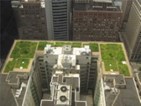American Chemical Society Launches "Green" Roof Project For Headquarters Building

The American Chemical Society (ACS), the world's largest scientific society, recently took another major step in transforming its headquarters into one of the most energy-efficient and sustainable structures possible with existing technology by starting construction of a meadow on the roof ? a "green roof" for its headquarters building.
Only 1 in 10 office buildings in the Washington, D.C., area have these innovative surfaces, according to Joanna Brosnan, director of ACS's Facilities Department, who initiated the project. Green roofs use green plants growing on a specially engineered surface to absorb carbon dioxide from the air, save energy on heating and cooling, promote cleaner air, and reduce stormwater runoff that can overburden city sewers.
When completed in the autumn, the ACS' Clifford & Kathryn Hach Building, 1155 16th Street NW, will sprout a garden consisting of a specialized mix of plants that thrive in the harsh, dry, hot conditions that exist at roof level. Employees will be able to enjoy lunch or breaks in an observation area and enjoy the wildflowers, grasses, and water-storing, drought-resistant flowering sedums in the meadow-on-the-roof."
"We are delighted to be able to transform our headquarters building into an even-more environmentally friendly and sustainable structure," said Madeleine Jacobs, ACS Executive Director and CEO. "This project is consistent with the core values of ACS, the world's largest scientific society ? to work for a more sustainable city, country, and world."
Green roofs:
- Retain stormwater. Most stormwater from rooftops in cities washes into the municipal storm sewer system, sometimes leading to flooding, sewage backup, congestion of waterways and water quality problems. The green roof will absorb up to 90 per cent of rainwater and snowfall melt.
- Improve air quality. One square meter of green roof can filter approximately 4.4 lbs of polluting aerosol dust and smog particles from the air each year. In addition, the roof's plants and soil absorb nitrates and other harmful materials in the air and from rainfall.
- Lessens the "heat island" effect. Heat given off by residential buildings, industry, and traffic make cities hotter than the suburban areas. Scientists term this ? the higher temperature in cities –– the urban heat island effect. Green areas and parks, including green roofs, help control the heat island effect.
- Increases energy efficiency. Green roofs can cut energy use for a building by lowering the air-conditioning costs for that building.
Michigan State University scientists, in a study published in ACS' Environmental Science & Technology, report that that replacing traditional roofing materials with green in an urban area the size of Detroit, with a population of about one-million, would be equivalent to eliminating a year's worth of carbon dioxide emitted by 10,000 mid-sized SUVs and trucks.
The green roof is just the latest in a series of projects to make the Hach building a more sustainable structure, including some that have brought national honors. In 2009, for instance, the ACS Facilities Department was awarded Gold Certification for the ACS Hach building in the Leadership in Energy and Environmental Design, Existing Building: Operations and Maintenance (LEED-EB O&M) program, sponsored by the U.S. Green Building Council (USGBC). The USGBC is the nation's leading non-profit authority for green buildings and is a nationally accepted benchmark for the design, construction, and operation of high performance green buildings. The U. S. Environmental Protection Agency (EPA) has awarded the Hach Building an Energy Star rating each year since 2006 for energy efficiency.
ACS in 2008 gave the Hach building a white roof with white coatings that reflect the sun, and help reduce energy consumption associated with summer cooling.
The Society also is deeply involved with protecting the environment through its ACS Green Chemistry Institute (ACS GCI), which works to promote green chemistry and green engineering in all aspects of the global chemical enterprise.
"I'm really excited about this project," said Brosnan "It's important for ACS to continue to be in the forefront of the environmental sustainability movement for the community and for its members." She noted that the D.C. Anacostia Watershed Society (AWS), through the D.C. Department of the Environment, will award ACS a rebate on the green roof project. Furbish Co. of Brooklyn, Md., a firm specializing in "living" roofs and walls, is the contractor for the green roof project, Brosnan said.
About The American Chemical Society
The American Chemical Society is a non-profit organization chartered by the U.S. Congress. With more than 161,000 members, ACS is the world's largest scientific society and a global leader in providing access to chemistry-related research through its multiple databases, peer-reviewed journals and scientific conferences. Its main offices are in Washington, D.C., and Columbus, Ohio.
SOURCE: The American Chemical Society
